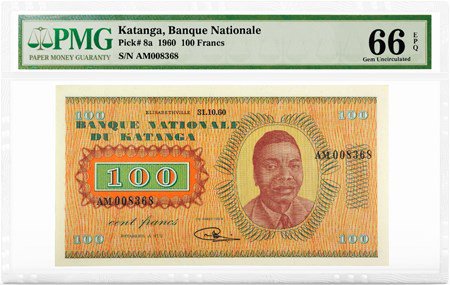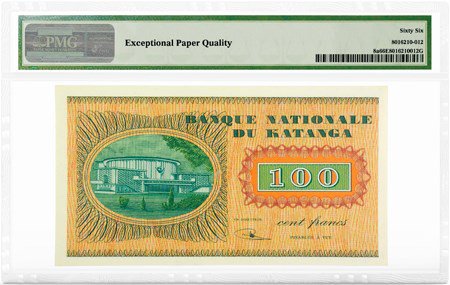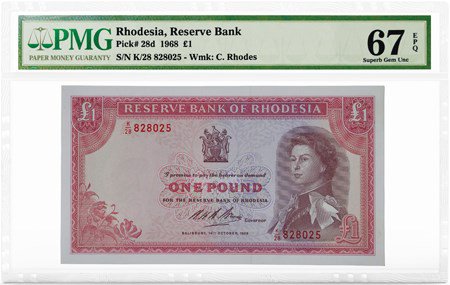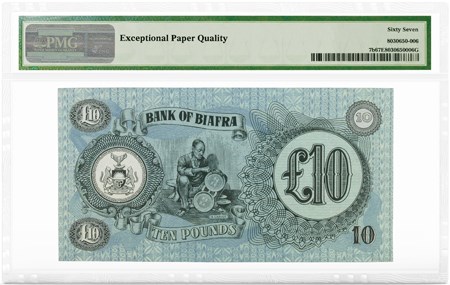African Banknotes -A complicated history of independent states and their efforts to remain free from colonial rule
There have been a litany of unrecognized countries over the last few centuries, and we will highlight a number of these nations in this two-part article series.
As you will see, there is a complicated history of independent states and their efforts to remain free from colonial rule reflected in the African Banknotes. While some countries were more successful than others in achieving their goals, today the influence of outside governance is thankfully gone. One hopes that these nations can continue their progress toward modernization and that systemic problems such as poverty and starvation can be quelled in the coming years.
Katanga

Katanga, Banque Nationale, Pick# 8a, 1960 100 Francs, PMG Graded 66 Gem Uncirculated EPQ, front. All images courtesy PMG.

Katanga, Banque Nationale, Pick# 8a, 1960 100 Francs, PMG Graded 66 Gem Uncirculated EPQ, back.
Africa in the 1960s was a tumultuous region, and the central African state of Katanga is one such example.
During the Congo Crisis that began in 1960, numerous regions that used to belong to the Belgian Congo attempted to declare themselves as sovereign states. Katanga was supported by the Belgian government because of the region’s wealth and stability, and its pro-West leader Moise Tshombe wished to keep the natural resources of copper, gold and uranium out of Soviet hands. After Congolese Prime Minister and independence advocate Patrice Lumumba was overthrown and was executed by his former army chief of staff Mobutu, UN forces deposed Tshombe in 1963 and banished him to exile.
Author Owen Linzmayer reveals that initially Rwanda and Burundi notes were overprinted with “Gouvernement Katanga” on both sides. Also, Waterlow & Sons attempted to win over the Katangese government by designing several different notes themselves. Both the overprinted and W&S notes are scarce, but the Katangese francs issues starting on January 9, 1961 are more readily available. The notes were issued in 10-, 20-, 50-, 100-, 500- and 1,000-franc denominations on January 9, 1961. A second series was issued between 1962 and 1963 with watermarked versions of the 100-, 500- and 1,000-franc notes[1].
Rhodesia

Rhodesia, Reserve Bank, Pick# 28d, 1968 £1, PMG Graded 67 Superb Gem Unc EPQ, front.

Rhodesia, Reserve Bank, Pick# 28d, 1968 £1, PMG Graded 67 Superb Gem Unc EPQ, back.
In 1965, a Unilateral Declaration of Independence (UDI) was issued as an attempt for the mostly white Rhodesian government to retain power in spite of two African nationalist movements led by Robert Mugabe and Joshua Nkomo. Prime Minister Ian Smith rejected the United Kingdom’s mandate to allow majority rule of black citizens, among other equality laws. Rhodesia was not recognized, despite continuing trade with other nations, something that the United Kingdom attempted to discourage.
The Bush War with the nationalists came to an end after peace talks granted free elections in 1980, which resulted in Mugabe’s election as Prime Minister and a name change to Zimbabwe.
According to Linzmayer, one of the effects of the UDI related to Rhodesia’s currency, as the nation was formerly a part of the sterling zone since the 1930s. The Reserve Bank board placed an order of 20 million notes in October 1965 to Bradbury, Wilkinson & Co. (BWC). However, Rhodesia declared its independence the following month, and the board was replaced the month after that.
As a result, the new board ordered a new series of banknotes from Giesecke & Devrient (G&D). A court case followed, resulting in the destruction of the G&D notes, and the refusal of an export license for the BWC notes. This forced the fledgling government to print their notes themselves without imprint. The Reserve Bank issued banknotes in three denominations: 10/- Shillings, £1, and £5 with issue dates of June 1, June 15, and July 1, 1966, respectively[2].
Biafra

Biafra, Bank of Biafra, Pick# 7b, ND (1968-69) £10, PMG Graded 67 Superb Gem Unc EPQ, front

Biafra, Bank of Biafra, Pick# 7b, ND (1968-69) £10, PMG Graded 67 Superb Gem Unc EPQ, back
The Nigerian Civil War was one of many conflicts in 1960s Africa relating to independence from colonial rule.
The Republic of Biafra was directly involved, as their majority population was the indigenous Igbo people who were persecuted by the Nigerian government and desired both self-governance and control over their oil reserves. On May 30, 1967, Colonel Odumegwu Ojukwu declared the Republic of Biafra’s independence, which was met with embargoes from many nations.
Biafra did not go completely unrecognized, as five countries acknowledged its independent status (Tanzania, Gabon, Côte d’Ivoire, Zambia and Haiti). Without access to outside resources or oil for trade, starvation set in, and outside attention led to humanitarian efforts despite resistance from the Nigerian government, who ended the war on January 13, 1970, with Biafra rejoining Nigeria.
Ojukwu desired for the Nigerian pound to remain as the new nation’s currency, but the Igbo pushed for their own currency. The resulting banknotes were Biafran pounds, of which the £1 note was issued on January 28, 1968, followed by £5 and £10 notes a month later.
According to Peter Symes, formerly of the International Bank Note Society (IBNS), many Biafran pounds were never delivered to the nation, and as a result the notes that were not destroyed after the war flooded onto the collector market, driving down their value. In addition, the Biafran government itself sold complete sets of the second series (5s and 10s coins and £1, £5, and £10 notes) for £20 (~$28.94 today) to collectors specifically, and Symes indicates that large dealers likely purchased many of these notes.
* * *
Notes
[1] Linzmayer, Owen W. The Banknote Book: Katanga. Self-Published. 1-3. (2014)
[2] — The Banknote Book: Rhodesia. Self-Published. 2. (2014)
PMG is an independent member of the Certified Collectibles Group (CCG).




